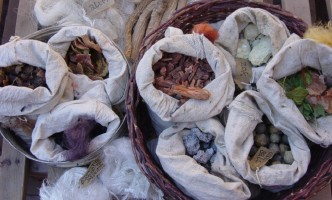Our dyes vary in price and availability. 'Barkh', a blend of onion skins, vine and quince leaves, gives us a vibrant mustard yellow and is made cheaply from the contents of our back garden. Pomegranate skins, likewise, are readily available and yield a rich gold colour.
Indigo, on the other hand, is imported from India (via Afghanistan) and is a lot more expensive. We're now trying to grow our own indigo. The leaves, once fermented, produce a vivid blue colour. Interestingly, nothing gives us green, so we have to dye first yellow and then blue, making consistent green the hardest colour to achieve.
The various shades of red are obtained from the dried and powdered root of the madder plant. A weak dye bath gives us creams and peach tones, whilst a stronger bath gives us salmons and corals. To achieve a strong red we mix in oak gall, a natural source of ferrous oxide that doesn't give any colour by itself but brightens the madder root, giving us crimsons and scarlet shades. We can also add zok to produce a rich burgundy.

Dried walnut husks are the secret ingredient in most natural self tanning lotions and turn silk, as well as skin, brown. For our dark blues our main ingredient is zok. We buy this elusive sulphuric chalk from northern Afghanistan, giving us numerous border hassles along the way, due to its likeness to a better known export, heroin. It doesn't give any colour by itself but when mixed with oak galls and pomegranate skins it produces a midnight blue. Substituting pomegranate for salt gives us a smoky greyish blue. The nearest we get to black is by dyeing brown skeins blue. Iron oxides produce wonderful blacks but is very corrosive.







